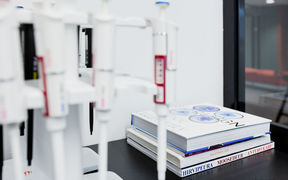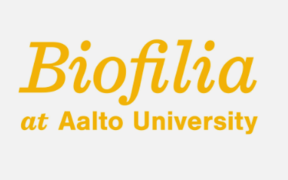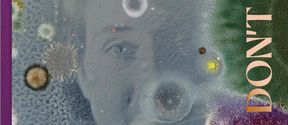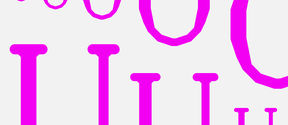Art as We Don’t Know It invites readers into the fascinating world of bioart
Art as We Don’t Know It presents a richly illustrated selection of artworks and bioart research.

Could you please briefly talk about your background? Have you worked in a transdisciplinary research unit like Biofilia before?
Marika Hellman: My name is Marika Hellman and I am the Lab Manager of Biofilia.
Biofilila was started in 2012 and I was there in the beginning to set up the lab and I have been working there intensively ever since. And my background is in microbiology.
James Evans: I’m James Evans, I’m the previous Lab Manager of Biofilia, when Marika was away for a certain time. My background is in molecular, cellular biology and different areas of medicinal chemistry.
What kind of opportunities has Biofilia brought for the organization/ Aalto university?
Marika Hellman: We are providing a space for students and artists to work and collaborate together, or to be involved in the separate projects.
Several bio artists across the world have been invited here, and they showed Aalto students how they can work and how they can process their artworks.
James Evans: As an example, last spring Guy Ben-Ary from Australia came and he set up several workshops and also had a show at Heureka, in Vantaa. And that was very exciting for the students because they got to see an actual practising artist preparing the show.
Could you please also talk about your support to the next generations, your collaboration with Aalto Junior?
Marika Hellman: We are collaborating with Aalto Junior, which is this kind of open window for high school students and even younger students to see university-level activities. I think the youngest is a six-year-old who has been working there. This is truly a window where they can see how real scientists and real artists are using the space in the lab. They also have access to the Biofilia materials and equipment.
Have you observed any change in your scientific approach over time since you have started working in collaboration with artists?
Marika Hellman: Yes of course. Just the vocabulary for example, how I talk about things has changed. And the fact that you don’t need to have a kind of defined aim for your research. You can just stop and see what are the interesting aspects and then change your targets with the new aim on the way.
James Evans: I write less, for better or for worse. It is more like a `do and see` approach than it is a `plan and execute` approach. And it has real advantages. When you’re planning something, just simply in your mind, you can always think of the things that will go wrong. It is quite easy to convince yourself or someone else to not do it, or to do it some other way based on your speculation or planning. But if you simply do something simple and it works, then you realize that it works and you can just run with it without having a precise plan that you’ve done.
To what extent could art extend the boundaries of science in a scientific laboratory?
Marika Hellman: There isn’t any strict protocol that artists need to follow. And I think the most passionate or kind of interesting thing is that you can approach the same dilemma as the researchers would do, but you don't have to stick into the ways how things have been done before. You have this kind of fresh approach and more visual approach, not just numbers and data, but kind of visualizing really difficult scientific things.
James Evans: It’s also a great way to sort of learn these techniques. From the perspective of trading scientists, oftentimes the tasks are not visually interesting, or they’re not open questions really. They’re simply written lab work kinds of tasks. But nonetheless, you have to do those things to learn how to perform experiments and how to work with organisms.
But bio art is unique in that you actually are doing something that is aesthetically fascinating and pleasing, and at the same time you’re using the same techniques you would be using in an actual scientific laboratory. So it’s very good, it’s much more engaging for students to do this kind of work than to do your standard introductory laboratory tasks in a course. So both sides complement each other quite well in this.
What are the challenges and opportunities of working with artists in a lab setting?
Marika Hellman: You have always this kind of fresh approach. No matter if the artists had worked previously in a laboratory setting or not, they still have this really unique way of approaching things, and doing things, and planning things. And you can always learn something from there.
James Evans: I think the most obvious thing is that because it is a teaching lab for artists, and it’s a bio art lab, very few of the students have an in-depth background for this kind of work. And it makes the position of someone like Marika or I very important, because we have to be the ones who actually figure out if the work is possible or not.
There are particular training things in scientific work which are perhaps unique to the scientific work. I’ve learnt that maybe you do not have to be as precise as our training has told us in scientific education. Certainly, artists are generally less precise working with things. It is a different mindset. It’s more journey-like and less destination-like.
Based on your own experience, what kind of long-term transformations might be needed at the infrastructural level to support and encourage trans-, post-, para-disciplinarity in art&science or biological art practices in a more sustainable way?
Marika Hellman: The key thing is that academics in Aalto University or in general would be aware of how they can apply this specific space in their teaching. So, it doesn’t need to be this kind of one whole course running from beginning to an end in the laboratory circumstances, but rather it should also include the way they could use the tools and kind of materials not only in the course they are teaching but also in their own working.
James Evans: If more students took courses from other areas of interest, I think it would give them a broader understanding of things. Like for example, if chemistry or engineering students took visual arts courses. Or if arts students or design students took the basic chemistry or biology courses.
If the students just had a few courses which had nothing to do with their area of focus, it would sort of broaden them up and give them new ideas about what to, what they can do in the lab.
What kind of changes or challenges (conceptual, ethical, and practical) could be expected in the field of biological arts and art & science in relation to the paradigm shift coronavirus pandemic have brought to (life) sciences?
James Evans: I mean, there’s a very wide, sudden interest in the viruses now. I answered lots and lots of questions about genetic sequencing, even before the virus. This has really kind of stuck into the student's heads somehow.
Have there been any particular influences of Covid-19 restrictions & reactions to ongoing research projects at the Biofilia?
Marika Hellman: There is a restriction on how many people can use the space at the same time. This has a direct influence on courses that we organize, so there isn’t any training there, and that limits the amounts of students who have access to the space. So, at the moment, we have just students who have already started with their projects earlier and kept working on it.
James Evans: It’s very challenging to organize a workshop. I’m now at a different lab and we’re trying to organize workshops, and I’m saying okay, well, we can have maybe three students in the lab and the instructor has to be outside of the lab elsewhere with the rest of the students, and then I have to rotate in groups of like three students at a time. And what this means is that tasks which would normally take twenty minutes or something are now going to take like two hours.
Marika Hellman: And that also affects the kind of experience that the students are having. There is a lot of waiting and a lot of repetition. I would say that it’s not so enjoyable for the students either to have this kind of workshop at this moment.
James Evans: And they don’t have the group wow factor, which is important when everyone’s in a group and they see something that they really like, or they think it’s cool. There is less group feeling.
How do you see the biological arts developing in the future?
Marika Hellman: When there is more and more collaboration, the projects are getting more and more complicated and connected with everyday life. There is more collaboration of any kind in different art fields and there have been several examples how bio art can be used there. And I think this is going to be employed and kind of spread in the future.
James Evans: Many of the artists that we work with don’t, or some of them do, but many of them don’t actually tell people that `I’m a bio artist`. It’s more like, they are artists and they just happen to be using biology. I suppose painters might say, I’m a painter` I don’t think it’s as important that they see themselves as bio artists bringing forward the field of bio art as such. But they realize that they can do things with these materials and in these ways, and get a sort of aesthetic appeal that you can’t get with something else. Like you can paint in any color you want, that’s trivial. But to paint in something that changes over time or that grows or paints with you, or is doing the painting by itself, you can’t do that with colors that you can buy. For the future it would just be nice that people realized that they can use these techniques and materials in a way and they can bring something to the piece that wouldn’t otherwise be there.
The interview was conducted by Bilge Hasdemir on October 13, 2020 at Aalto University.
Marika Hellman M.Sc. (Tech.) graduated from Aalto School of Chemical Technology, Department of Biotechnology and Chemical Technology. Since 2012 she works as laboratory manager at the Biofilia – Base for Biological Arts. This is part of the technical infrastructures of Aalto University. In this unique bioart laboratory she provides safe environment to work with living material and develop further their work. In this laboratory the main users are students and staff from School of Arts, Design and Architecture.
`Labs and Actors` text by Laura Beloff as part of the Outre: Encounters with Non/Living Things Exhibition

Biofilia – Base for Biological Arts, a biological art unit was launched under the School of Arts, Design and Architecture in 2012. It offers a platform for trans-disciplinary research and education that aims to create cultural discussions and innovations around the topics related to the manipulation of life and biological processes at a practical and theoretical level, including philosophical and ethical dimensions.

Biofilia provides artists, researchers, students and scholars with the ability to engage with the life sciences and their applications within an artistic and cultural context, thus making creative and critical links between biosciences, engineering and the arts.


Art as We Don’t Know It presents a richly illustrated selection of artworks and bioart research.

`Outré: Encounters with Non/living Things` online exhibition